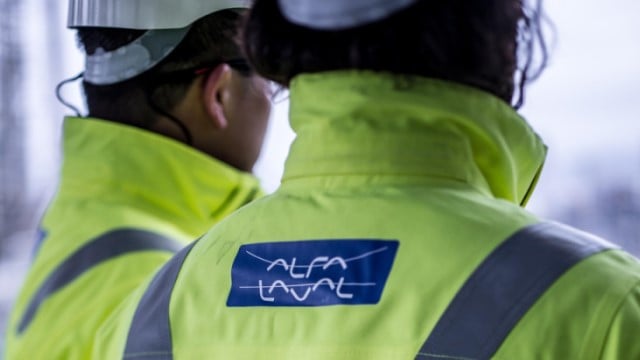CDNX
Alfa Laval CDNX centrifugal decanter systems are made for muck handling. They efficiently remove solid particles from water and oil-based slurries resulting in better penetration rates, shorter drill times, less wear on key components as well as longer sludge service life. It also reduces chemical usage as well as drill waste, which contributes to lower disposal and waste water treatment costs.
Ease of operation and high uptime
- Developed specifically for the tunnel boring and construction industry
- Small footprint – easy installation and mobilization
- Continuous and automatic operation with option of remote surveillance
- High separation efficiency – clean slurry improves drill penetration rate
- Highly sustainable cleaning capacity – less waste due to dry cake and reused slurry
How it works
The Alfa Laval CDNX decanter centrifuge is based around a slender cylindrical bowl with a relatively large length:diameter ratio and a conical end. The bowl rotates at speeds of up to 5,200 rpm (depending on model) producing a centrifugal force of between 300 and 3574 G.
The key components include a main drive motor, heavy-duty gearbox, back drive motor and control panel. The direct drive gearbox enables you to automatically control the conveying speed.
The liquid drilling slurry is fed into the long cylindrical bowl, where the centrifugal force presses it outwards to form a layer (known as the pond) around the wall. The thickness of the pond is determined by a series of discharge weirs at the end of the cylindrical section. The clarified liquid flows out over the weirs with the aid of centrifugal force. Since the solids in the slurry are heavier, they remain plastered against the bowl wall and are continuously removed by the screw conveyor. They are then transported up to the conical section (known as the beach) where they exit via the discharge ports at the narrow end. Cleaned drilling slurry exits at the opposite end.
Get a quick quote!
Get more details on a construction drilling decanter for waste water and slurry treatment by generating a quote instantly. Click on the link or use the QR-code to get to the quotation template.
* You will be redirected to another platform.
> Request for quote - Decanter
Innovative technology for civil drilling
Alfa Laval decanter centrifuges are key to achieving high efficiency in drilling and tunnelling, especially in terms of treatment of slurries and water cleanliness. The technology efficiently removes most of the fine particles that traditional slurry treatment equipment cannot without recourse to polymers. Due to specific design for construction sites and tunneling environments, the Alfa Laval decanter centrifuges cope with abrasive and coarse particles and can handle large volumes of feed solids and various flow rates.
The decanter centrifuges are available with a range of modules ideally suited for every kind of solids separation job. They range from fully automated operation to simple “hands-on” capabilities. Whichever you choose, you can look forward to effective solutions to your separation needs.
The importance of cleaning waste water at your construction site
The construction and engineering industries play a crucial role in the continued social and economic development of our world. Any serious project (whether public or private) is now subject to requirements to minimize impacts on people and the environment. A contractor’s environmental impact assessments (EIA) and environmental management plans (EMP) set the minimum levels for efficient use of resources, the protection of biodiversity, climate change and, not least the risk of accidents and the protection of our health in general.
An important part of a construction project’s EIA is water management, especially in civil engineering. Water plays a key role whether it is used in excavation and foundations, to cool machines, keep pressure, move solids (for example tunnel boring machines, drilling rigs and cutting machines) or as a means of cleaning. Rainwater and effluent seepage also need to be managed. Companies that can optimize consumption and ensure water meets the national and local regulations regarding cleanliness will always be at an advantage.
Alfa Laval’s range of centrifuge decanters are built to meet the high environmental demands for solid-liquid separation in tunnelling construction and similar applications. The proven separation technology removes the finest particles (unlike sedimentation tanks) making it easier to meet requirements for water disposal or re-use, such as suspended solids, acidity (pH), and biological and chemical oxygen demand. Low operating costs and high separation capacity help contractors to compete effectively and to meet these evermore-stringent environmental demands.
How can we help you?
If you have any questions about Alfa Laval’s solutions for slurry separation, contact us so that we can together discuss how our purpose-built centrifugal decanters can save on cost by bringing further efficiency to your drilling operations.


